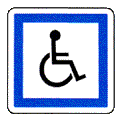 It
might seem an advantage: Visually, it is virtually impossible to « tell » if a
person suffers from a visual impairment or from severe eye pain for that matter.
It is, however, easy to notice the disability of a person sitting on a
wheelchair or equipped with some kind of visible prosthetic device or even a
blind person, whereas pain and visual impairment cannot be perceived by the
untrained eye. The obvious advantage being
that there is no first-sight
discrimination unless the disability becomes more visible…except
when a dry eye sufferer has to use drops every 5 minutes.
It
might seem an advantage: Visually, it is virtually impossible to « tell » if a
person suffers from a visual impairment or from severe eye pain for that matter.
It is, however, easy to notice the disability of a person sitting on a
wheelchair or equipped with some kind of visible prosthetic device or even a
blind person, whereas pain and visual impairment cannot be perceived by the
untrained eye. The obvious advantage being
that there is no first-sight
discrimination unless the disability becomes more visible…except
when a dry eye sufferer has to use drops every 5 minutes.
Nevertheless,
this is often a
setback and
frustrating problem causing of
further distress for the individual:
as it may be almost impossible to make others understand that “the normal
appearance” of a person suffering from severe ocular diseases is
completely misleading.
This incapacity to perceive the disease is often a cause of incomprehension even
amongst the closest persons or relatives. This is a common characteristic of
most chronic diseases which cannot be perceived by others (the visual
impairment, physical pain and moral pain is not in “the eye of the beholder"
simply looking at it but rather in that of the person suffering from a severe
ocular pathology). This is particularly true in a world of deceitful binary
misconceptions (good sight vs. blind, whereas visual impairment exists in may
degrees or forms; pain acknowledged by physicians vs. psychosomatic
interpretations of that pain, when pain can only be perceived subjectively… no
matter what doctors may tell you… and, of course, this is not the patient’s
fault).
The best way to quantify pain
sometimes is to
listen to the patients symptoms (taking a subjective approach)...
take a headache for instance.
Most pathologies addressed by Keratos are precisely a combination of a visual
impairment with a real physical pain, without excluding moral pain.
Most persons suffering from these diseases carry “the burden of proof” to use a
juridical analogy. For instance, they have to justify themselves whenever they
need to rest or get way from the others, whenever they need to limit their
activities, whenever they need to avoid
certain environments
likely to worsen their health state. A frequent example:
ciagarette smoke in the immediate
surroundings of the person suffering from an ocular surface disease or it
could be some
heated room (artificial
heat) and air conditioning.
Very often, even close relatives take it quite badly when it
is required of them to stop smoking in the presence of the diseased person,
asked to reduce heating equipment or air conditioner use.
Hence, it is even more difficult in daily life situations
for persons in which a
disability is not obvious
and with people one does not know:
at work or at a restaurant for example. In some cases the use of protective
sunglasses is not socially accepted or can be misinterpreted as “showing off”;
when worn in places where sunglasses are not usually expected, for example
inside buildings, in malls or at work, or school. This
type of disease usually ends up forcing their sufferer to become asocial against
his will.
Even with physicians or ophthalmologists it is sometimes hard to address the
issue of pain and the disability ocular surface diseases
causes.
OSD not only cause visual impairment but also "ocular pain" disability, teh
cornea is the most sensitive tissue of the human body, doctors know it, and yet
.... It is fairly easy to explain this fact, since neither pain nor even
photophobia can be objectively measured. Furthermore, society as a whole, has
just begun to take an interest in pain control while at the same time theories
that minimize the impact of pain flourish (everything is psychosomatic,
psychological, etc). Medicine has often had to re-evaluate its subjective
considerations on other’s suffering… everyone who’s suffered from severe
neuralgias in the past decade knows that.
For those who do not
suffer from this type of ocular pathology, it is difficult to understand the
chronic ocular pain, the fatigue it induces, and the heavy and constant
treatments it imposes. The daily impact of this chronic eye pain is not
recognised by many ophthalmologists (who believe artificial tears are the
answer), this is surprising since our sight is
also
involved in 80% of our daily
tasks.
Thus, we acknowledge
that there is a huge challenge ahead of us. One of which is to help society
finally recognize that ocular surface diseases are serious disabilities, and
have not yet received proper attention.
Keratos and its members
intend to raise awareness amongst the general public, the medical community,
laboratories, governmental and health-related institutions about these
distressing conditions on the threshold of both visual impairment and ocular
pain disability,
which we believe is
possible. We are also
convinced that measures can be taken to ensure that theses pathologies will
receive a better care someday (ex: studies on the impact on the
quality of life, by adapting the
scales which are use to measure different disabilities
and notably the impact of chronic pain and constant stress caused by these
pathologies, by inciting laboratories to research dry-eye treatments that go
beyond the usual palliative solutions, etc).
▲

copyright ©
Keratos 2005-2007